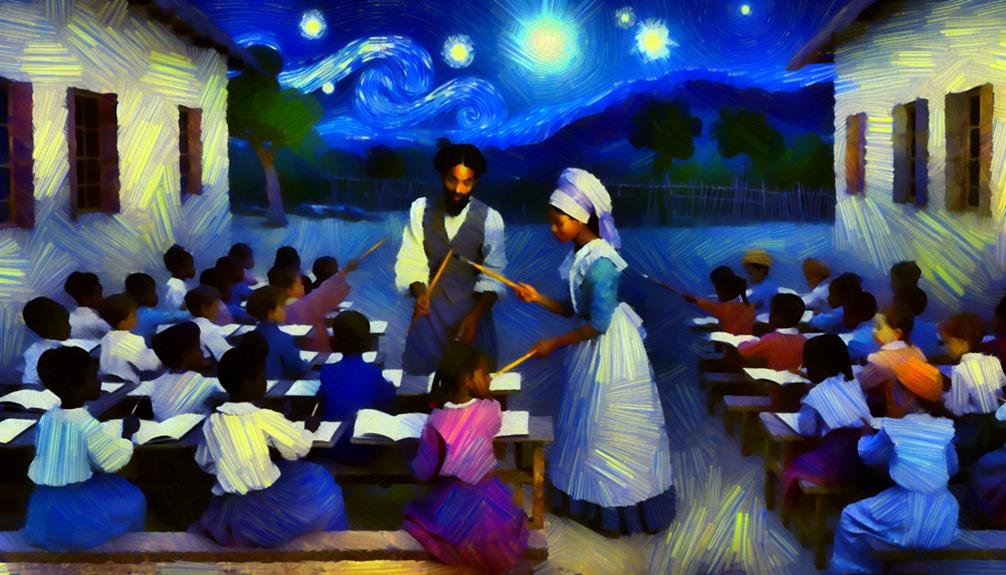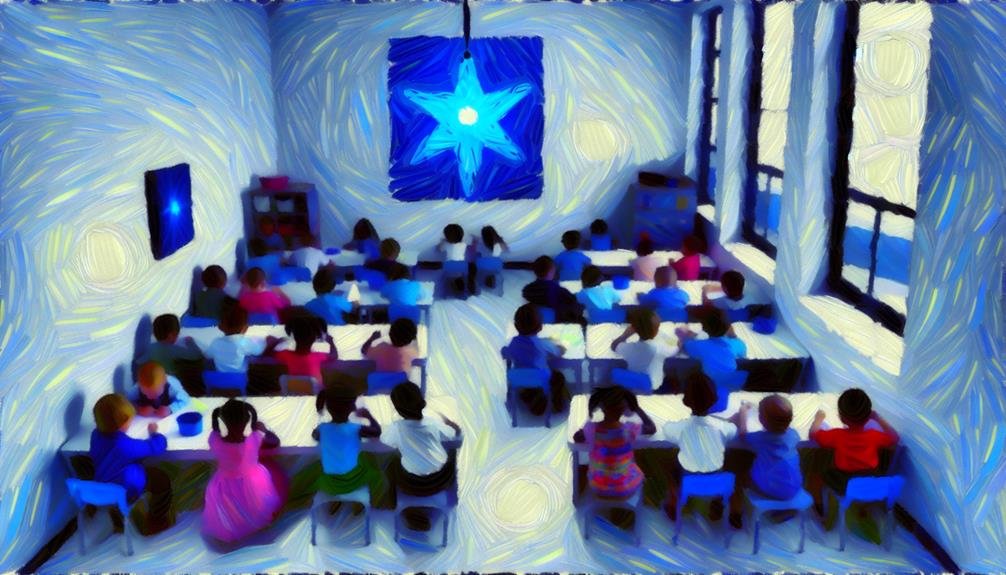The Creative Curriculum offers numerous benefits, including alignment with state standards, age-appropriate learning objectives, and a focus on developmental needs. It equips educators with user-friendly resources and a goal bank for IEPs. However, it demands perfect behavior, lacks adaptations for special education students, and the quick pacing may result in gaps in understanding. The curriculum also limits the personalization of lessons and may not suit every student's preferences. By exploring strategic adaptations and inclusive practices, educators can better address these challenges and enhance the effectiveness of the curriculum.
Takeaways
- Aligns with state standards and developmental needs of students.
- Utilizes user-friendly resources but may not adapt well for special education.
- Quick pacing could result in gaps in understanding for some students.
- Read-aloud texts often fail to meet the diverse needs of all students.
- Offers a goal bank for IEPs but demands near-perfect student behavior.
Advantages of Creative Curriculum
Creative Curriculum frequently offers significant advantages to educators by aligning with state standards and providing age-appropriate learning objectives. This alignment guarantees that teachers can meet educational requirements seamlessly while focusing on the developmental needs of their students.
The curriculum is meticulously broken down by age groups, allowing educators to present material that is both engaging and suitable for the developmental stage of their students, thereby creating a more conducive to learning environment.
Additionally, Creative Curriculum incorporates a thorough goal bank for Individualized Education Programs (IEPs). This feature empowers educators to tailor their teaching strategies to meet the unique needs of each student, fostering a more inclusive and effective learning experience. The curriculum's user-friendly resources simplify its implementation, making it accessible for teachers who may have varying levels of experience and expertise.
Furthermore, the surplus of resources provided by Creative Curriculum equips educators with a wide array of materials designed to enhance their teaching strategies. These resources can include lesson plans, activity guides, and assessment tools, all aimed at enriching the classroom experience.
Disadvantages to Consider

While Creative Curriculum offers numerous advantages, several disadvantages must also be considered for a thorough evaluation. One notable drawback is the lack of consideration for behavior management. The curriculum often demands perfect behavior from students, which may not be realistic in diverse classroom settings. This can pose significant challenges for educators who need to address a range of behavioral issues.
Another critical issue is the insufficient adaptation for special education students, particularly regarding AAC accommodations. The curriculum does not adequately cater to students requiring alternative and augmentative communication methods, thereby limiting inclusivity and equitable learning opportunities.
Additionally, the quick pacing of lessons can hinder a thorough understanding and mastery of concepts. Students may struggle to keep up, leading to gaps in knowledge and comprehension. The rigidity of the curriculum also limits personalization, preventing educators from tailoring lessons to meet individual student needs effectively.
Moreover, the read-aloud texts provided may not suit the diverse needs or preferences of all students, further hampering engagement and learning outcomes.
| Aspect | Issue | Impact on Students |
|---|---|---|
| Behavior Management | Unrealistic expectations | Challenges for educators |
| AAC Accommodations | Insufficient adaptation | Limits inclusivity |
| Lesson Pacing | Quick pacing | Gaps in understanding |
| Curriculum Flexibility | Lack of personalization | Hinders tailored learning |
| Read-Aloud Texts | Inadequate diversity | Affects engagement |
Effective Implementation Strategies
To maximize the benefits of the Creative Curriculum, educators must employ strategic adaptations and targeted supplemental activities. Adaptation strategies and customization options are essential to guarantee the curriculum addresses the unique needs of all students, particularly in special education. By dissecting the Creative Curriculum to select suitable components, educators can make necessary modifications while maintaining alignment with state standards.
Inclusive practices and differentiated instruction play pivotal roles in effective implementation. Adapting lesson plans to cater to individual learning needs ensures that every student has access to quality education. Utilizing tools such as Mighty Minutes for quick activities and creating focus question cards can greatly enhance student engagement. These engagement techniques, complemented by interactive elements, make learning more dynamic and accessible.
Incorporating alternative read-aloud texts and collaborating with colleagues to develop mini-book series can further enrich the curriculum. These strategies not only diversify the learning materials but also foster a more inclusive classroom environment.
Overcoming Common Challenges

Addressing the diverse learning styles of students is essential for the successful implementation of the Creative Curriculum. Effective management of resource allocation and ensuring consistent assessment practices are also key components in overcoming common challenges.
Addressing Diverse Learning Styles
Effectively addressing diverse learning styles within the Creative Curriculum necessitates thoughtful adaptations to guarantee inclusivity and accessibility for all students. Individualized adaptations are essential to meet the unique needs of each learner, especially those in special education. By employing inclusive approaches, educators can create an environment where all students, including those who rely on Augmentative and Alternative Communication (AAC), can thrive.
| Adaptation Strategy | Description | Benefit |
|---|---|---|
| Individualized Adaptations | Tailoring lessons to meet specific needs | Enhances learning for students with special requirements |
| Inclusive Approaches | Integrating resources for diverse learners | Ensures equal access for all students |
| Varied Assessments | Utilizing multiple forms of evaluation | Accommodates different learning styles |
The Creative Curriculum's quick pacing may present challenges for students with varying learning speeds. Therefore, varied assessments are essential to gauge understanding and progress effectively. These assessments can range from traditional tests to project-based evaluations, ensuring that each student has the opportunity to demonstrate their knowledge in a manner best suited to their learning style. Implementing strategies to address diverse learning styles can greatly enhance the curriculum's effectiveness, ensuring that all students, regardless of their learning needs, can access and benefit from the educational material provided.
Managing Resource Allocation
Managing resource allocation within the Creative Curriculum requires strategic planning and innovative solutions to guarantee equitable access to materials for all students. Effective budget management is paramount, as educators often face limited financial resources. Prioritizing essential materials and seeking creative ways to repurpose items can stretch budgets further while maintaining the quality of education.
Implementing a material rotation system is another effective strategy. By rotating resources among different classrooms or groups, educators can make sure that all students benefit from a diverse range of learning tools without the need for excessive duplication. This not only maximizes the use of available materials but also reduces storage challenges.
Family involvement can greatly enhance resource allocation. Encouraging families to donate unused items or contribute to classroom supplies can supplement budget constraints. Additionally, organizing community drives or seeking partnerships with local businesses can provide an influx of necessary resources.
Creating a detailed resource inventory also aids in managing supplies efficiently. By tracking available materials and their usage, educators can plan better for replenishments and avoid unnecessary purchases.
Ensuring Consistent Assessment
Ensuring consistent assessment in the Creative Curriculum often requires tailored strategies to meet diverse student needs and align with state standards. One significant challenge lies in making individualized adaptations for special education students, particularly considering AAC accommodations and behavioral management. These adaptations guarantee that assessments accurately reflect each student's capabilities and learning progress.
Additionally, the rapid pacing of the curriculum can lead to rushed or incomplete assessments, further complicating the evaluation process.
To overcome these challenges, educators can employ several strategies:
- Individualized adaptations: Tailor assessment methods to meet the unique needs of each student, ensuring that all learners are accurately evaluated.
- AAC considerations: Integrate Augmentative and Alternative Communication tools to facilitate more effective communication and assessment for students with speech or language impairments.
- Behavior management: Implement behavior management techniques to create a conducive assessment environment, thereby improving assessment accuracy.
- State standards: Continuously align assessment methods with state standards to ensure that all evaluations meet regulatory requirements.
- Curriculum alignment: Regularly review and adjust the curriculum to ensure that assessments are reflective of the learning objectives and standards.
Maximizing Student Engagement

Maximizing student engagement within the Creative Curriculum framework hinges on implementing interactive learning techniques. Utilizing diverse learning materials is also crucial for creating engaging lessons. Additionally, crafting student-centered activities plays a pivotal role in keeping students motivated and invested. These elements not only promote active participation but also cater to varying learning preferences. This ensures that all students remain engaged in the learning process. By focusing on these strategies, educators can create dynamic and inclusive learning environments. These environments foster deeper levels of student involvement.
Interactive Learning Techniques
Interactive learning techniques in the Creative Curriculum greatly enhance student engagement by incorporating hands-on activities and group discussions that cater to diverse learning styles. These methods foster active participation, leading to better retention of information and increased motivation among students. Utilizing interactive tools like visual aids and technology integration further supports different learning preferences, ensuring that every student benefits from the curriculum.
Incorporating interactive learning techniques can create a dynamic and stimulating classroom environment. The following elements highlight the benefits of such an approach:
- Hands-on experiences and group discussions: These activities encourage students to actively engage with the material, promoting deeper understanding and critical thinking.
- Visual aids and technology integration: Tools such as multimedia presentations and interactive software cater to visual learners and enhance comprehension.
- Active participation: Students are more likely to retain information when they are actively involved in their learning process.
- Collaborative projects: Group activities build communication and teamwork skills, fostering a sense of community.
- Real-world applications: Connecting lessons to real-life situations makes learning more relevant and engaging for students.
Diverse Learning Materials
Building upon the benefits of interactive learning techniques, the Creative Curriculum's use of diverse learning materials further amplifies student engagement by catering to a wide array of learning styles and preferences.
Incorporating hands-on activities, manipulatives, and books, this curriculum creates a dynamic and interactive learning environment that promotes active student involvement. Hands-on activities allow students to engage directly with the material, fostering a deeper understanding and retention of concepts.
Manipulatives, such as counting blocks or geometric shapes, offer tangible ways for students to explore mathematical and scientific principles, making abstract ideas more accessible.
Books, carefully selected to complement the curriculum, provide both informational and narrative content that stimulates students' imaginations and critical thinking. By offering a range of these diverse resources, the Creative Curriculum enables teachers to differentiate instruction effectively, meeting the unique needs of each student.
This approach not only engages students but also encourages creativity, critical thinking, and problem-solving skills, contributing to a well-rounded educational experience. In sum, the use of diverse learning materials within the Creative Curriculum plays an important role in maximizing student engagement and fostering a supportive, inclusive, and stimulating classroom environment.
Student-Centered Activities
The Creative Curriculum's emphasis on student-centered activities actively engages learners by placing their interests and abilities at the forefront of the educational experience. This approach encourages active participation and fosters significant student progress. By focusing on personalized learning, the curriculum tailors educational experiences to individual needs, thereby maximizing student engagement and enhancing overall learning outcomes.
Key benefits of student-centered activities in the Creative Curriculum include:
- Active participation: Students are more engaged when they are actively involved in their learning process.
- Student motivation: Personalized activities tap into students' interests, keeping them motivated and enthusiastic to learn.
- Collaborative projects: Working in groups fosters teamwork and enhances social skills and peer learning.
- Student feedback: Continuous feedback helps students understand their progress and areas for improvement.
- Independence and critical thinking: Hands-on activities develop critical thinking and problem-solving skills, encouraging students to take ownership of their learning journey.
Balancing Creativity and Standards

Finding a balance between fostering creativity and adhering to educational standards is essential for the effective implementation of the Creative Curriculum. The curriculum's design integrates creative approaches with standardized outcomes, guaranteeing that students engage in innovative activities while meeting state-mandated educational benchmarks. This integration is facilitated through curriculum flexibility, allowing educators to tailor learning experiences to meet diverse student needs without compromising on educational rigor.
One of the strengths of the Creative Curriculum is its alignment with state standards, which assures that educational requirements are consistently met. By breaking down learning objectives by age, the curriculum ensures that each child engages in age-appropriate learning experiences, fostering development at every stage. Additionally, the curriculum offers a goal bank for Individualized Education Programs (IEPs), supporting personalized learning and addressing the unique needs of special education students.
User-friendly resources further enhance the curriculum's ease of implementation, enabling educators to effectively balance creative teaching methods with the need to achieve standardized outcomes. However, while the focus on creativity is a significant advantage, educators might need to make specific adaptations when working with special education students to make certain that all learners benefit equally from the curriculum's offerings.
Frequently Asked Questions
What Are the Advantages of Creative Curriculum?
The Creative Curriculum provides benefits such as extensive teacher resources, an enriched classroom environment, and enhanced parental involvement. These elements collectively guarantee a well-rounded educational experience tailored to diverse developmental levels and learning needs.
What Are the 5 Fundamental Principles of Creative Curriculum?
The five fundamental principles of Creative Curriculum are individualized learning, hands-on experiences, meaningful interactions, fostering development through play, and promoting social-emotional growth. Effective implementation requires thorough teacher training, active parent involvement, and holistic assessment methods.
What Is the Main Idea of the Creative Curriculum?
The main idea of the Creative Curriculum is to provide an educational framework that emphasizes thorough lesson planning and effective teaching strategies, promoting holistic development in early childhood across social-emotional, physical, cognitive, and language domains.
Is Creative Curriculum Child Centered?
Yes, Creative Curriculum is child-centered. It emphasizes project-based learning and child-led activities, providing ample exploration time. This approach supports individual interests and developmental levels, fostering autonomy, decision-making, and social-emotional growth among children.
Conclusion
In evaluating the creative curriculum, both its strengths and weaknesses become apparent.
Effective implementation strategies and overcoming common challenges are essential for success.
Maximizing student engagement while maintaining a balance between creativity and educational standards ensures a holistic learning experience.
The creative curriculum holds significant potential for fostering innovation and critical thinking in students, provided that it is thoughtfully integrated into the educational framework and continuously assessed for efficacy.

